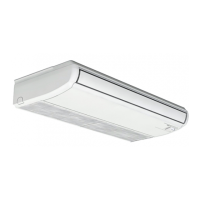15.2.2 Harmonics
In relation to EN 61000-3-2, the situation of harmonics for each
model is as follows:
Situation of the models in relation to EN
61000- 3-2
Model
Equipment complying with EN 61000-3-2 RPC-(1.5-3.0)FSR
Installation restrictions may be applied by
supplied authorities in relation to harmonics
RPC-(4.0-6.0)FSR
15.2.3 Position of electrical wiring connection
! DANGER
• Tightly secure wirings to the terminal board according to the
specied torque. If tightening the terminals is not completed,
heat generation, an electric shock or a re will occur at the
terminal connection.
• Make sure that the wires are securely xed in order not to apply
an external force to the terminal connections of the wirings. If
xing is not completed, heat generation or a re will occur.
The connections at the terminal board for the indoor unit is
shown in the gure below. Check the outdoor unit for the
combination before the wiring work. The screws at the terminal
board should be performed according to the tightening torque as
shown in the table below.
Tightening torque for terminals
M4 1.0 - 1.3 (Nm)
Terminal board for power
source cable TB1 (black)
Terminal board for
control cable TB2 (white)
-
S/NR/L1
Controller
line
Communication
line
? NOTE
1* The shapes of the terminal block vary with the production date,
however, the electrical characteristics have not been changed.
! CAUTION
• Do not connect the main power source cables to the control line
(Terminals A, B, 1 and 2 of TB2). If connected, the printed circuit
board (PCB) will be broken.
• Pay attention to followings when wires are connected to terminal
board.
(A) Attach an insulation tape or a sleeve to each terminal.
(B) Maintain the distance between the electrical box and the terminals
to prevent a short circuit.
(C) Maintain the distance between the terminals.
(A)
(B)
Screw
Screw
1 Connect the cable for the optional remote control switch
or the optional extension cable to the terminals inside the
electrical box through the connecting hole in the cabinet.
2 Connect the power supply and the earth wires to the
terminals in the electrical box.
3 Connect the wires between the indoor unit and the outdoor
unit to the terminals in the electrical box.
4 Connect cables correctly to match the terminal No. and the
mark band.
5 Connect the transition wires between indoor units connected
to the same outdoor unit.
6 Do not connect the main power source cables to the control
line (Terminals A, B, 1 and 2 of TB2). If connected, the
printed circuit board (PCB) will be broken.
7 Tightly clamp the wires using the cord clamp inside the
electrical box.
8 The wiring work for the indoor unit should be performed
according to the electrical wiring diagram and Installation
and Operation Manual of the outdoor unit.
9 Remote control switch connection
a. Installing remote control switch to each unit with
individual operation setting.
Outdoor unit
Indoor unit Indoor unit
Remote
control
switch
Remote
control
switch
b. Installing one remote control switch with individual
operation setting.
Outdoor unit
Indoor unit Indoor unit
Remote
control
switch
The transition wiring
for the remote control
switch is required.
ELECTRICAL WIRING
PMML0551 rev.4 - 07/2023 - A10762310A
24

